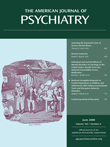To The Editor: In their article, published in the February 2008 issue of the
Journal, Kamryn T. Eddy, Ph.D., et al.
(1) supported the removal of the subtyping schema for anorexia nervosa. Given that some of their findings confirm the distinction between restricting-type and binge eating/purging-type anorexia nervosa, their conclusions may be premature. In their study, both the overall rate of crossover and the rate of crossover to bulimia nervosa were lower in the subgroup of patients with restricting-type anorexia nervosa. Although the authors did not report a statistical test pertaining to the rate of crossover for the two anorexia nervosa subtype groups, the differences were highly significant (p<0.005, using likelihood-ratio chi square).
The representativeness of the study sample should also be considered. The low number of subjects with restricting-type anorexia nervosa (as well as those with nonpurging bulimia nervosa) and the high diagnostic instability in this subgroup
(1) prompts us to consider whether there may have been some form of bias in the recruitment method. The ratios between the two anorexia nervosa subtypes in an adult community sample
(2) and among patients consecutively referred to our outpatient unit (anorexia nervosa subjects: N=540) were 3:1 and 2.5:1, respectively, in favor of the restricting type. Since the development of binge eating in restricting-type anorexia nervosa seems to delay the time to recovery
(3), it is possible that the high duration of illness in this subgroup could explain, at least in part, any possible bias. In our community study
(2), more than one-half of the subjects with lifetime anorexia nervosa demonstrated complete remission after a duration of illness of 14 months, on average.
In addition, the rate of observed crossover can be highly influenced by the duration and type of treatment. In a series of 168 patients with restricting-type anorexia nervosa, the rate of subjects who developed binge eating during 17 months, on average, of outpatient treatment was 14%. However, only 2% of these patients (N=4) experienced a diagnostic crossover
(3) . Although examining the effects of treatment on diagnostic shifts was not one of the objectives in the study conducted by Dr. Eddy et al., we feel that particular caution is needed in defining a diagnostic crossover when treatment is ongoing (especially inpatient treatment). It would be more cautious to use a longer threshold of duration of the current episode before considering the change of symptoms as a diagnostic crossover.
We agree with Dr. Eddy et al. in that it is important to consider the presence of symptoms from a longitudinal perspective and not only at assessment. However, too few data are available to propose the removal of the subtyping schema for anorexia nervosa. Contrarily, we feel that it is time to consider the inclusion of the characteristic of diagnostic stability/instability among the criteria for subtyping eating disorders.

